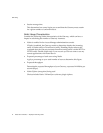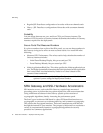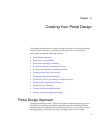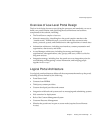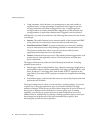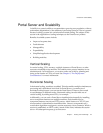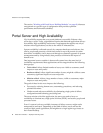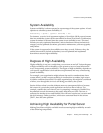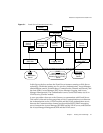Portal Design Approach
80 Portal Server 6 2005Q1 • Deployment Planning Guide
Your high-level portal design communicates the architecture of the system and
provides the basis for the low-level design of your solution. Further, the high-level
design needs to describe a logical architecture that meets the business and technical
needs that you previously established. The logical architecture is broken down
according to the various applications that comprise the system as a whole and the
way in which users interact with it. In general, the logical architecture includes
Portal Server Secure Remote Access (SRA) , high availability, security (including
Access Manager, and Directory Server architectural components. See “Logical
Portal Architecture” on page 81 for more information.
The high- and low-level designs also need to account for any factors beyond the
control of the portal, including your network, hardware failures, and improper
channel design.
Once developed, the high-level design leads toward the creation of the low-level
design. The low-level design specifies such items as the physical architecture,
network infrastucture, Portal Desktop channel and container design and the actual
hardware and software components. Once you have completed the high- and
low-level designs, you can begin a trial deployment for testing within your
organization.
Overview of High-Level Portal Design
The high-level design is your first iteration of an architecture approach to support
both the business and technical requirements. The high-level design addresses
questions such as:
• Does the proposed architecture support both the business and technical
requirements?
• Can any modifications strengthen this design?
• Are there alternative architectures that might accomplish this?
• What is the physical layout of the system?
• What is the mapping of various components and connectivity?
• What is the logical definition describing the different categories of users and
the systems and applications users have access to?
• Does the design account for adding more hardware to the system as required
by the increase in web traffic over time?





